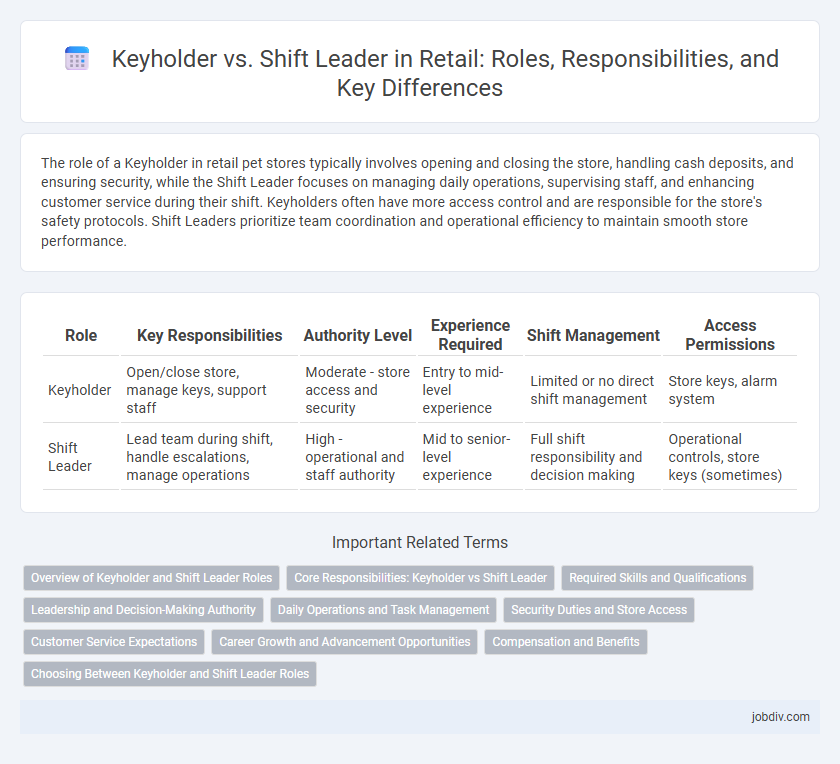The role of a Keyholder in retail pet stores typically involves opening and closing the store, handling cash deposits, and ensuring security, while the Shift Leader focuses on managing daily operations, supervising staff, and enhancing customer service during their shift. Keyholders often have more access control and are responsible for the store's safety protocols. Shift Leaders prioritize team coordination and operational efficiency to maintain smooth store performance.
Table of Comparison
| Role | Key Responsibilities | Authority Level | Experience Required | Shift Management | Access Permissions |
|---|---|---|---|---|---|
| Keyholder | Open/close store, manage keys, support staff | Moderate - store access and security | Entry to mid-level experience | Limited or no direct shift management | Store keys, alarm system |
| Shift Leader | Lead team during shift, handle escalations, manage operations | High - operational and staff authority | Mid to senior-level experience | Full shift responsibility and decision making | Operational controls, store keys (sometimes) |
Overview of Keyholder and Shift Leader Roles
Keyholders in retail are responsible for opening and closing the store, securing merchandise, and handling cash management, ensuring operational security during shifts. Shift Leaders oversee daily store operations, manage employee tasks, and ensure customer satisfaction while supporting store managers in maintaining sales targets. Both roles require strong leadership skills, with Keyholders focusing on store accountability and Shift Leaders emphasizing team coordination and customer service.
Core Responsibilities: Keyholder vs Shift Leader
Keyholders are primarily responsible for opening and closing the store, securing cash handling, and managing store access, ensuring operational security outside regular hours. Shift Leaders oversee daily team management, task delegation, and customer service quality during their shifts to maintain smooth store operations. Both roles share accountability for staff supervision and problem resolution but differ mainly in their focus on store security (Keyholder) versus team leadership and workflow management (Shift Leader).
Required Skills and Qualifications
Keyholders in retail need strong customer service skills, basic cash handling experience, and the ability to open and close the store independently. Shift Leaders require advanced leadership abilities, including team management, conflict resolution, and knowledge of inventory control and daily operations. Both roles typically demand prior retail experience, strong communication skills, and reliability during varying shift hours.
Leadership and Decision-Making Authority
Keyholders often hold foundational leadership responsibilities, granting them access control and some decision-making power during store operations. Shift Leaders possess broader authority, overseeing team management, resolving conflicts, and making critical decisions to ensure smooth shifts and achieve sales targets. Both roles require strong leadership skills, but Shift Leaders have expanded decision-making authority to drive operational efficiency and customer satisfaction.
Daily Operations and Task Management
Keyholders and Shift Leaders both play crucial roles in retail daily operations, but their responsibilities differ significantly in task management. Keyholders primarily grant access to the store, handle opening and closing procedures, and ensure security protocols are followed, while Shift Leaders focus on managing team performance, delegating tasks, and maintaining operational flow during their shifts. Effective coordination between these roles optimizes store efficiency, customer service, and adherence to company policies.
Security Duties and Store Access
Keyholders typically hold responsibility for opening and closing the store, managing security systems, and ensuring all access points are secured during their shifts. Shift leaders oversee staff operations but may have limited access to security protocols and store keys compared to keyholders. Retail security duties prioritize risk prevention, loss control, and authorized access, which are often more emphasized in the keyholder role.
Customer Service Expectations
Keyholders and shift leaders both uphold high customer service standards, ensuring a seamless shopping experience and swift issue resolution. Shift leaders often manage escalated customer concerns, providing support and guidance to staff on delivering exceptional service. Keyholders play a pivotal role in maintaining store operations while fostering a customer-centric environment during their shifts.
Career Growth and Advancement Opportunities
A Keyholder role in retail often serves as a foundation for career growth, providing early leadership experience and responsibility for store opening and closing procedures. Shift Leaders advance beyond keyholder duties by managing entire teams during shifts, enhancing skills in staff supervision, conflict resolution, and operational decision-making. Transitioning from Keyholder to Shift Leader signifies a critical step toward management positions, increasing opportunities for career advancement within retail organizations.
Compensation and Benefits
Keyholders in retail typically receive hourly wages with occasional bonuses tied to store performance, while shift leaders often earn higher hourly rates and eligibility for more comprehensive benefits such as health insurance and paid time off. Shift leaders carry additional responsibilities like managing staff and handling customer issues, which justifies their enhanced compensation packages compared to keyholders. Understanding these distinctions helps retailers design competitive pay structures that align with role expectations and employee retention goals.
Choosing Between Keyholder and Shift Leader Roles
Choosing between keyholder and shift leader roles in retail depends on responsibilities and career goals; keyholders manage store access and security with limited supervisory duties, whereas shift leaders handle team management, customer service, and operational tasks during shifts. Keyholders often focus on opening and closing protocols, while shift leaders oversee daily team performance and problem-solving. Prioritizing leadership development and operational control can guide the choice effectively.
Keyholder vs Shift Leader Infographic

 jobdiv.com
jobdiv.com